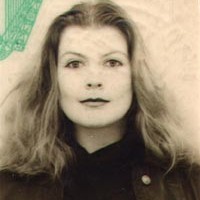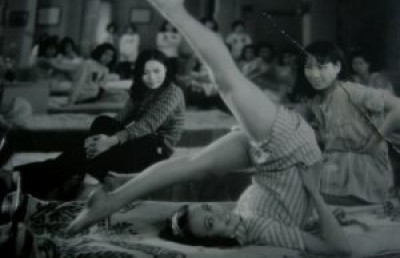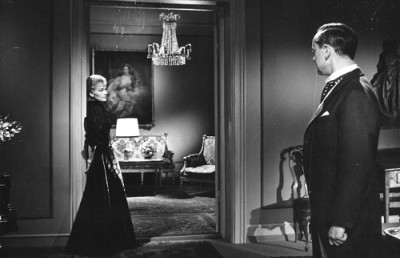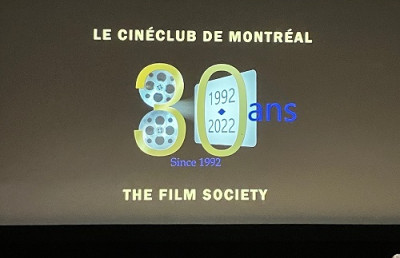The Girl Who Knew Too Much: Shadow of a Doubt (1943) Part One, The Gothic Girls of Hollywood
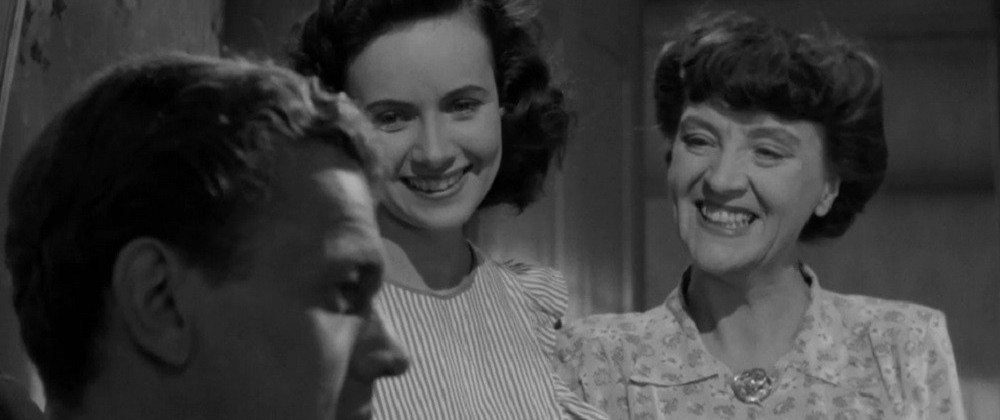
I am an observer of life.
-Alfred Hitchcock
(Chandler, 2005: 330)
Homesick
Robin Wood famously asked why it was that we should take Alfred Hitchcock seriously – and he then proceeded to explain (Wood, 2008). Hitchcock has long been an aesthetic construct as much as an infamous director but he remains an essential filmmaker not least because he made films that, for the most part, people wanted to see and they continue to enjoy today. His avocation of the common man; his dedication to the quotidian; and his purveying of entertainment for its own sake, endeared him to the general public and yet his technical approach to story retains its fascination for student and fan alike. One of the ongoing matters for cinéphiles is not just the affect of Hitchcock’s output but the methodology by which it was achieved: his manner of work, his dedication to style (and its relationship to content) and his very singular shooting process which were quite particular to him and inimical to the classical studio preference for coverage – master shots, close ups and reverse angles that could be shaped by the cutters into conventionally palatable fare. How that relates to the kinds of stories he told is what concerns us here with the assumptions of formal and aesthetic preoccupations which were somehow transmuted into themes of transference, guilt and the cliché of the woman in peril.
Shadow of a Doubt (1942) apparently remained the director’s favourite of his own films throughout his lifetime. He stated that this was because “suspense and melodrama combined well with character.” (Talking Pictures: Alfred Hitchcock) The film was in production during 1942, the year that the United States had finally entered the Second World War following the attack on Pearl Harbor. Set in a northern California town, it features the troublesome reappearance of the charming and enigmatic Uncle Charlie (Joseph Cotten) into the sleepy average life of his sentimental older sister Emma Newton (Patricia Collinge) and her young family, when his namesake teenage niece (Young Charlie) wishes from him some excitement. Daughter Patricia Hitchcock would say of this film many years later, “He loved the thought of bringing menace into a small town.” (Beyond Doubt: The Making of Hitchcock’s Favourite Film). It represented the first truly independent film of the American phase of the director’s career after he had developed a series of projects with David O. Selznick. It could even be described as his first American film proper, utilising tropes from the theatre through the work of Thornton (‘Our Town’) Wilder and a setting in contrast with his previous city and cross-country locations. It was also unique in that it was shot on location, principally due to restrictions imposed by the war (Friedrich, 1986: 11). Young Charlie in Shadow of a Doubt wants a miracle to save the family, but for Peter Conrad, “when Hitchcock moved to America he found that miracles were available to order, since the country’s technology performed supernatural feats all day long” (Conrad, 2000: 45). The lure had been the opportunity to film an adaptation of Daphne du Maurier’s Rebecca.
The pattern of Hitchcock’s cinematic output had been determined in his long career in England where he forged his stylistic signature in a confluence of Hollywood melodrama, Soviet montage and German Expressionist techniques, most recently in the suspense thriller format which he so admired in novels of the period. From the point of view of narrative, his preferred screenwriters Elliott Stannard and Charles Bennett, specialised in just such mechanistic genre works which now provided the Hitchcock signature, including elements of low comedy, stock characterisation and opportunities for technical experimentation.
His aesthetic can largely be traced to the influence of German cinema which Gottlieb categorises as pure cinema, Expressionism, Kammerspielfilme, street films; and the work of fellow directors F.W. Murnau, E.A. Dupont and Fritz Lang. (Gottlieb, 2002: 35-58) Patrick McGilligan comments on Hitchcock as Lang’s bête noire; he also states that Lang was hugely influenced by Rebecca (McGilligan, 2003: 372; 353).
As is customary in auteurist accounts of artists and filmmakers, an element of psychobiography is introduced in analysis of Hitchcock, sometimes to the point of overwhelming otherwise sensible discussion (for instance Donald Spoto’s controversial account, The Dark Side of Genius, 1983). Peter Conrad declares: “Hitchcock personified the art he practised. In exploring its possibilities, he discovered himself, and the medium’s technical edicts became the constituents of his bizarre and violent world-view” (Conrad, 2000: 141). Sarah Churchwell states on the subject:
Like Othello turning a handkerchief into what he will call proof of an adultery in which he already believes, so too can biography build a framework upon evidence whose very flimsiness demonstrates the firmness of the opinions it already holds.
(Churchwell, 2004: 111)
However the Freudian interpretation has certain ramifications for a reading of Shadow and on a personal level Hitchcock’s own situation has been used as a prism that yields some insights. Spoto claims, “for the first time in his life, the usually secretive Hitchcock poured his soul into the first spiritually autobiographical film of his career” (Spoto, 1983: 269). As biographer John Russell Taylor states, by 1938 Hitchcock had gone as far as was possible in the limitations of the English film industry and from both a stylistic and technical point of view he welcomed the opportunity to work in Hollywood (Taylor, 1978: 137-146). In an interview that year the director himself said of his prospective production of Rebecca,
This is really quite a new departure for me. It concerns the wife of a rich young man who feels that the house in which she lives with her husband is haunted by some malignant influence. Subsequently she discovers that her husband murdered his former wife. I shall treat this more or less as a horror film, building up my violent situations from incidents such as one in which the young wife innocently appears at the annual fancy-dress ball given by her husband in a frock identical with the one worn by his first wife a year previously. When Rebecca is finished I may stay in Hollywood or come home – I don’t know! (Gottlieb, 1995: 200-201)
In 1939 he could write, “to the student of motion picture making, Hollywood is a vast laboratory… in England (I) found myself hindered or even thwarted by cost of operation, lack of technical skill, the obstacle of tradition – a British one this time” (Op.cit.: 203).
The Hitchcocks quickly acclimatised to life in southern California. Taylor points out that 1942 was the year the Hitchcock family finally purchased a home in the United States – in fact, they bought two. One was to become their holiday home in northern California at Santa Cruz, while their principal residence was on the opposite side of the golf course from the late Carole Lombard’s house which they’d been renting in Los Angeles. While the director was finally putting down roots in his adopted home he was constantly engaged in contract negotiations with Selznick, to whom he had promised two films a year (McGilligan: 308).
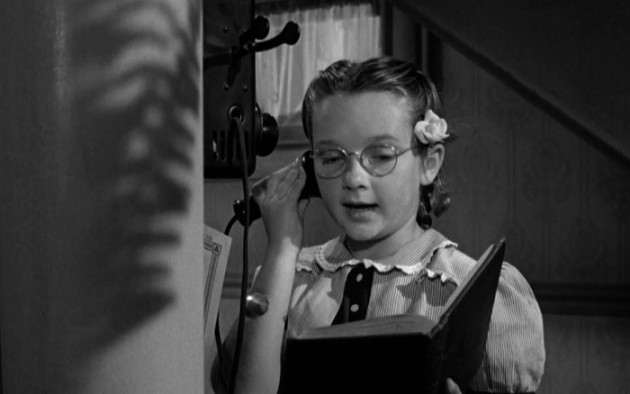
Ann immersed in Ivanhoe
The family in Shadow could be seen to have certain echoes in Hitchcock’s own. Emma is named for Hitchcock’s mother, who always shouted down the telephone. The Newton family’s next door neighbour Herbie Hawkins (actor and writer Hume Cronyn) is a double for Charlie’s father, Joe, another crime obsessive with both men representing the director in some shape or form. Hitchcock himself was obsessed with crime and took a particular interest in the way in which it was reported. The violence of twentieth century life and the reportage which characterized daily newspapers was one facet of modernity which dominated not just this but all of his screen stories: Young Charlie discovers her uncle’s secret courtesy of his obsessive interest in concealing certain pages from her father’s daily newspaper. Revisiting the idea of the serial killer (from The Lodger, 1927) but placing him in the small-town beloved of women’s films was an intriguing prospect (and a departure from Gordon McDonell’s original idea.)
Joe Newton doesn’t drive the family automobile and leaves those duties to Young Charlie: Hitchcock could drive but preferred not to (and often used the excuse that he was afraid of being pulled over by the police, enhancing his much-repeated fabled time in a prison cell as a young child to teach him a lesson). The atmosphere in the United States was febrile. The film went into production soon after the entry into World War Two and the studios were slashing their budgets to save materials so location shooting made economic sense. Carole Lombard had been killed in a plane crash while on a tour selling war bonds. Hitchcock was deeply affected by the loss of his friend and star, and purchased a home in that neighbourhood for the sum of $40,000, the precise amount that Uncle Charlie lodges in Mr Newton’s bank in the film.
We can never go back again, that much is certain. The past is still too close to us. The things we have tried to forget and put behind us would stir again, and that sense of fear, of furtive unrest, struggling at length to blind unreasoning panic – now mercifully stilled, thank God – might in some manner unforeseen become a living companion, as it had before.
(Rebecca: 8)
The screenplay is shot through with elements of nostalgia. The title sequence opens on “waltzing figures. Middle-aged women in Edwardian dresses and their partners. They dance to the tune of the ‘Merry Widow Waltz.’ As the last title fades we get a clear view of them” (Shadow of a Doubt, Screenplay dated 10 August 1942: 1). We are immediately transported via lap dissolve in a series of long shots to the grim dirty abandon of the New Jersey marshes, filled with scrap and dumping grounds and the camera travels in through the window of a mean looking frame house on a street. We enter a shabby bedroom and the kaleidoscope of dancers and music fades away …
UNCLE CHARLIE
Emma! Don’t move! Standing there, you don’t look like Emma Newton … (he starts to walk towards Her)
…. You look like Emma Spencer Oakley of 46 Burnham Street, St. Paul, Minnesota.The prettiest girl on the block!
He continues;
I keep remembering those things. All the old things… Somehow, the world since …
(SoD: 28)
Raymond Durgnat was probably the first critic to refer to the Victorian ball that forms the linchpin of the editing choices in terms of “the delusions of nostalgia” (Durgnat, 1975: 185). The delimitations on presumed aspects of Hitchcock’s personality and life as they seem to occur in the narrative in disguised form are highlighted by Spoto: the naming of the mother for his own, who was seriously ill at the time; Joe as a Hitchcock figure, obsessed by true crime and replaced in his own home by this dangerously debonair cuckoo; his homsickness for England, which he couldn’t reach during wartime – home is similarly lost to both Emma and her brother through time and is expressed frequently throughout the film by Uncle Charlie’s longing for the past, in Oklahoma. Indeed, Spoto reminds us that Hitchcock’s mother was in the family home at Shamley Green in England, slowly dying throughout the location filming of Shadow. She finally expired just as the shoot moved back to Hollywood for the studio element. Spoto states:
It is this single event, anticipated by months of anxiety, and followed by months of quiet sorrow, that transformed the entire enterprise of Shadow of a Doubt into a network of personal references.
(Spoto, 1983: 273)
Of course the screenplay had been completed at that point. Originally, nostalgia was understood as an illness and became the term used to describe soldiers afflicted with melancholy when far from home. In the United States approximately five thousand Union soldiers fighting in the Civil War were sent home (its only known cure). World War One had one known casualty from the malaise. Thereafter it wasn’t treated as a serious illness but merely as homesickness. “Too much nostalgia can leave you stuck between a dissatisfying present and an alluringly unavailable past. But often making a sudden connection with a long-lost memory creates welcome feelings of belonging, identity and continuity” (Watt-Smith, 2015: 19). This ‘symptom’ of the villain’s mindset is directly acknowledged in the script when Uncle Charlie addresses his sister as ‘Emma Spencer Oakley’ and later when Mrs Newton is explaining a childhood incident to Young Charlie while serving her brother breakfast in bed and the women examine the only photograph of him in existence, a childhood snap:
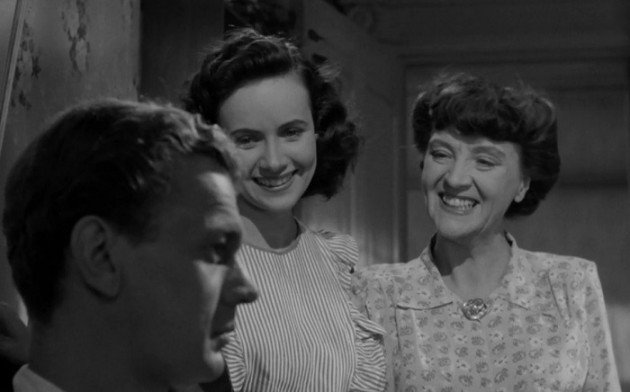
Mothering Uncle Charlie
MRS NEWTON
He had a fractured skull and he was laid up so long, and when he got well, there was no holding him. It was as though all that rest he got was too much for him and he had to get into all sorts of mischief to blow off steam.
(she laughs)
He didn’t read much after that, let me tell you!
UNCLE CHARLIE (looks at the picture and says under his breath)
The whole world’s rotten. The whole world’s changed. Everything’s different.
(SoD: 65)
His sister’s recollections distress him.
UNCLE CHARLIE
What’s the use of looking backward? What’s the use of looking ahead? Today’s the thing. That’s my philosophy. Today, today, today.
(SoD: 65)
This attempt to ascribe his sexual and murderous instincts to an ill-chosen childhood gift without finding fault in the family structure is “elementary Freudian metaphor for the trauma of premature sexual awakening” (Wood, 1989: 301).
Young Charlie’s modern restlessness is posited against nostalgia at regular intervals:
MRS. NEWTON
I’m glad you’re pleased, Charlie. But don’t set your heart on miracles. After all, just your uncle Charlie’s being here won’t make so much difference. We’re just medium people, and I’ve never minded.
YOUNG CHARLIE
But! I don’t want to be medium – I’d rather be dead.
(SoD: 36)
And this is echoed on page 61 of the screenplay when Mrs Newton explains to her brother that an organisation called the National Public Survey wants to interview the family. “He wanted a typical American family.” His disgust is balanced by her patriotism. When Graham and Saunders ascend the staircase to photograph Young Charlie’s bedroom they dismiss it as “typical girl. Typical room” (SoD: 78). Her comment is ‘Typical of you to ask.” And she, like her mother, criticises her shabby bedroom: “it isn’t really the way I’d like to have it.” (79) She continues:
YOUNG CHARLIE
… You know, your picking us out as an average family gave me kind of a funny feeling.
JACK
What kind of a funny feeling?
YOUNG CHARLIE
Oh, I don’t know. I guess I don’t like to be an average girl in an average family.
(SoD: 80)
The entire family’s status is raised a notch with the attention Uncle Charlie brings to them with interest from the Women’s Club and the local newspaper. The adults enjoy the gifts he bestows upon them – the younger children are disgusted by his infantile tastes. In another emphatic nod to nostalgia, he presents his sister with two restored daguerrotypes of their parents. (36)
UNCLE CHARLIE
Everyone was pretty and sweet, then, Charlie. The whole world … a wonderful world … not like the world today. It was great to be young then.(SoD: 36)
Young Charlie pronounces her delight at this miracle in their midst:
YOUNG CHARLIE
We’re happy now, Uncle Charlie. Look at us! For once we’re all happy at the same time.
(SoD: 37)
Producer Jack Skirball recognised that following the great success of Saboteur (1942) which although set in the United States had a great many elements of his later English thrillers, Hitchcock ought to pick a project of his own. The original idea came from Gordon McDonell, the husband of David O. Selznick’s story editor, Margaret. It was introduced to the director over a series of lunches in which he was hoping to find the subject matter for his next film. (Amongst other projects, he turned down an adaptation of Patrick Hamilton’s Gaslight which would boast as co-star Joseph Cotten, the villain here) It reminded Hitchcock of the true case of the Merry Widow Murderer, Earle Leonard Nelson, who was hanged for his killing spree in 1928. Uncle Charlie is introduced “fully dressed, meticulously neat, and the bed is not even ruffled. His hands are clasped behind his head … His hand is well-kept, steady and strong. He is in his early forties and has the eyes of a child. His mouth, though, is set with fatigue. He lights a cigarette and stares up at the ceiling.” Money is scattered on the nightstand and has fallen on the floor of the shabby room. The landlady calls him ‘Mr Spencer’ and says two men were looking for him (SoD: 2). Hitchcock never lost his interest in true crime (a preoccupation here for Joe Newton and neighbour Herbie Hawkins). This discussion resulted in a skeleton draft. The nine pages were sent to the playwright Thornton Wilder. The screenplay’s development is traced by Dan Auiler and George Turner (Auiler, 1999: 96-128; Turner, 1993). The six-page treatment by McDonell is called ‘Hitchcock #2 Untitled’ and is reproduced in Auiler. (This material is covered in Spoto, 1983: 267-281; Taylor: 182-186; and McGilligan, 2003: 307-321)
In development notes written by Hitchcock on the ‘Uncle Charlie’ story dated 11 May 1942 he says
It should start out as a comedy of small town manners with the implication that after the arrival of the Uncle and his subsequent happy effect on them all that something dramatic is going to happen between him and the daughter; that is to say, that her being attracted to him is going to possibly upset the harmonious state of affairs between the Uncle and the family.
(Auiler: 101)
He continues:
… several things stand out fairly clearly:
1. That the beginning of the story should be pure comedy.
2. That it should continue right through the scenes concerned with the Uncle’s arrival and his subsequent effect on the family.
3. From the point where the girl first suspects her Uncle, the comedy should continue as overtones right up to the end of the story and should be got from
4. the characters ‘not in the know’.
(Auiler: 102)
And:
If possible I am extremely anxious to avoid the conventional small town American scene. By conventional I mean the stock figures which have been seen in so many films of this type. I would like them to be very modern … by modern I mean … life in a small town lit by neon signs.
(Ibid.)
The second of his features for Universal Pictures, after Saboteur, Shadow featured a great deal of location filming, this time in upstate California wine country, in the sleepy town of Santa Rosa (pop.: 13,000). Accounts vary, but Hitchcock possibly stopped at a local fruit and vegetable store one day because it reminded him of his late father’s establishment (the stories vary from teller to teller). He spotted the proprietor’s daughter, Edna May Wonnacott, skipping in the street and selected her to play little Ann Newton, Young Charlie’s bookworm sister. She would be coached by his own teenaged daughter Pat, to whom she bore a strong resemblance and who was by then developing an interest in acting as a career. 1
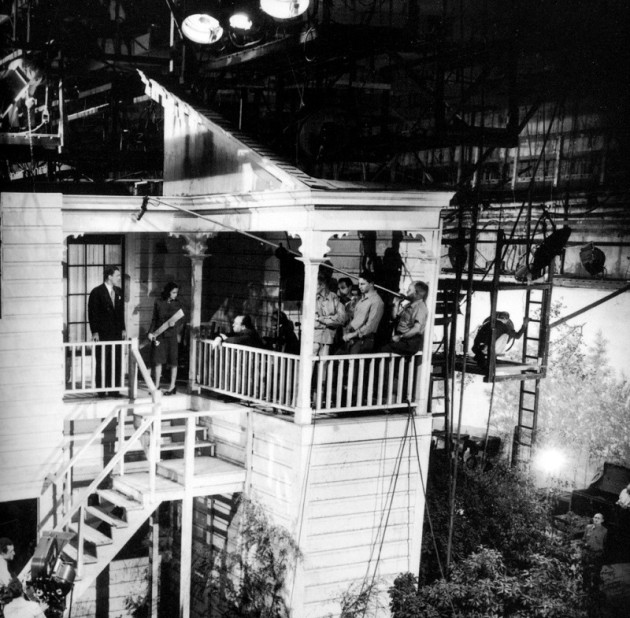
Great care was taken to have the interior of the house on McDonald Avenue in the heart of Santa Rosa rebuilt with the moving camera in mind when the crew returned
Great care was taken to have the interior of the house on McDonald Avenue in the heart of Santa Rosa rebuilt with the moving camera in mind when the crew returned to the studio once location filming was completed. It necessitated breakaway walls and prop dining tables to allow for cinematographer Joseph Valentine to achieve the film’s masterful look. The director’s commitment to reality is often discussed. Longtime Hitchcock collaborator, production designer Robert Boyle states:
With Hitchcock you stayed with this kind of reality so that he could play his fairytales against it – which made it more – as he once said, he said if you bring somebody into a kitchen and then jump up onto a kitchen table and scream, that’s shocking. But if the kitchen looks like Dr Caligari’s cabinet, you expect somebody
to jump up on a table and scream. And I think that was true. He did everything – he played everything – against reality.
(Living Famously: Alfred Hitchcock)
The director himself said
There is an important key to creating reality on the backlot. If you’re content to do a small portion of the set very accurately, it’s much better than trying to do a whole street. This is a principle which I’ve stuck to ever since I was an art director. I was working on the UFA lot in Germany in its heyday and there I picked up a lot about set building and perspective of every kind. I believe if you’re doing a thing on the backlot, you have to go out and get photographs of the real thing and reproduce a portion of it – but with complete accuracy.
(Gottlieb, 1995: 309-310)
The location shooting meant lighting blocks of streets at night, crowd control and filming the arrival of a train at the local railway stop. As ever, Hitchcock welcomed the technical challenges that such a production entailed.
In his famous series of conversations with François Truffaut, the director spoke fondly of the experience of his collaboration with playwright Thornton Wilder, whose name was suggested for the project by Sam Goldwyn’s literary agent in New York (McGilligan: 308).
He came right here, to this studio we are in now, to work on it. We worked together in the morning, and he would work on his own in the afternoon, writing by hand in a school note book. He never worked consecutively, but jumped about from one to scene to another according to his fancy. I might add that the reason I wanted Wilder is that he had written a wonderful play called Our Town.
(Truffaut, 1983: 152)
He explained his pleasure at this particular working relationship:
In England, I’d always had the collaboration of top stars and the finest writers, but in America things were quite different. I was turned down by many stars and by writers who looked down their noses at the genre I work in. That’s why it was so gratifying for me to find out that one of America’s most eminent playwrights was willing to work with me and, indeed, that he took the whole thing quite seriously.
(Truffaut: 151-2)
This was a significant departure for Hitchcock in terms of writing as it was the first film he had worked on without his trusted assistant Joan Harrison in ten years. Wilder then enlisted in the Psychological Warfare Department of the Army.
… I felt there was still something lacking in our screenplay, and I wanted someone who could inject some comedy highlights that would counterpoint the drama. Thornton Wilder had recommended an MGM writer, Robert Audrey, but he struck me as being more inclined toward serious drama, so Sally Benson was brought in.
(Truffaut: 152)
Truffaut asked Hitchcock about the unusual tribute to Wilder in the titles.
It was an emotional gesture; I was touched by his qualities.
(Truffaut: 153)
Ironically, Rohmer & Chabrol would decry the secondary figures as ‘caricature,’ laying the blame squarely with Wilder and his theatrical avocations (R&C: 73). Roger Ebert comes to something of the same conclusion, ascribing Hitchcock’s misjudgment to sentimentality and his mother’s demise mid-filming (Ebert, 2011: unpaginated). Indeed, according to Spoto, Wilder in fact “did little more than scout locations and work on a prose treatment” (Spoto, 1983: 268). By the end of May 1942 they had thirty pages.
Before the writing, Wilder and I went to great pains to be realistic about the town, the people, and the décor. We chose a town and we went there to search for the right house. We found one, but Wilder felt that it was too big for a bank clerk. Upon investigation it turned out that the man who lived there was in the same financial bracket as our character, so Wilder agreed to use it. But when we came back, two weeks prior to the shooting, the owner was so pleased that his house was going to be in a picture that he had had it completely repainted. So we had to go in and get his permission to paint it dirty again. And when we were through, naturally, we had it done all over again with bright, new colors.
(Truffaut: 153)
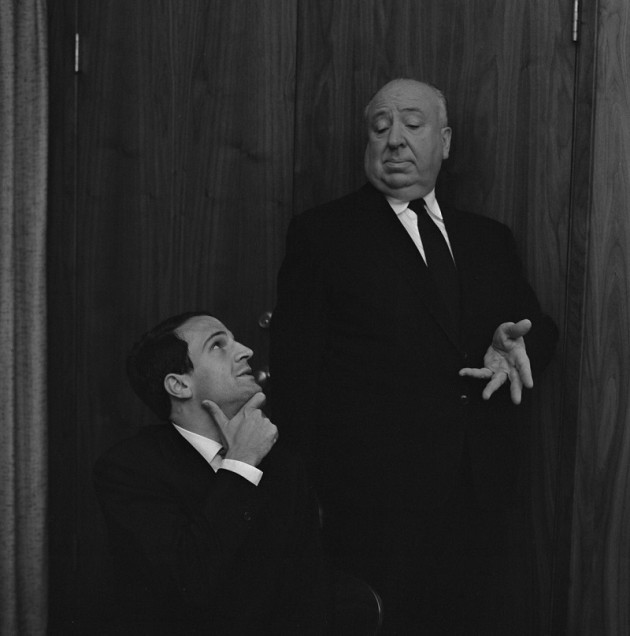
Hitchcock and his wife and muse Alma Reville completed the screenplay, but needed help with the younger children’s dialogue and wanted to inject a comic element to contrast with the drama. Hitchcock relied on his wife’s advice throughout his career. He wrote of her in 1956, “I suspect I’m accused a lot of overshadowing her. She does read for me and I rely on her opinion … She tries to be on set the first day we begin shooting a film, sometimes goes to rushes, and always gives me her criticisms. They’re invariably sound” (Gottlieb, 1995: 53). Sally Benson was supposedly responsible for the domestic comedy aspect of the work, being known for her expertise in juvenilia. At the time, she had a hit play on Broadway, Junior Miss. She would of course become better known for the musical screenplay based on her New York Post series of stories Meet Me in St Louis (Minnelli, 1944), another startling film about adolescents in suburbia which remains a sentimental favourite. At the request of Teresa Wright (Young Charlie), Irish-born actress Patricia Collinge rewrote a love scene between the girl protagonist and her romantic counterpart, the detective Jack Graham (Macdonald Carey), as if in counterpoint to the uncle’s sinister wooing of his seemingly impressionable namesake. Collinge also reduced the stereotypical ‘silly woman’ material to make her character more sympathetic. Michie claims that “the fact that Hitchcock used a woman writer to convey the closeness of the ties among the Newton family members and that he asked the actress who plays the mother to write the dialogue for the clearest love scene in the film suggests that he was interested not just in women’s voices but specifically in the maternal voice…” (Michie, 1999: 33). Michie further explores this dimension by comparing Shadow with The Little Foxes, Wyler, 1941, which of course starred Wright and Collinge (Michie: 37-39). However the screenplay credit to Wilder stands, with publications in his name, including, Shadow of a Doubt, Collected Plays and Writings on Theater. (Ed. J.D. McClatchy. New York: Library of America: 731-817).
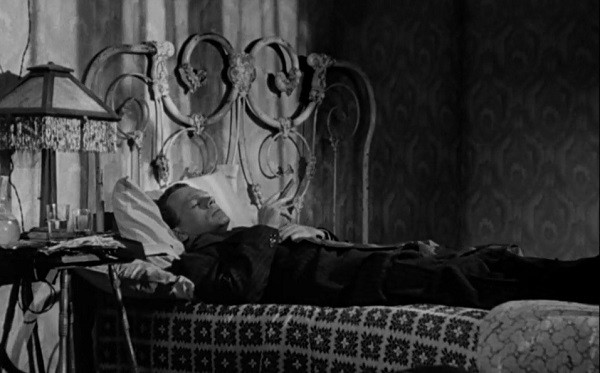
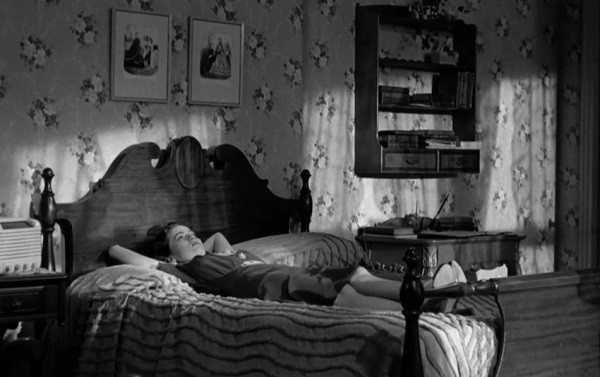
Corpse-like Uncle Charlie and Daydream believer Young Charlie
In Shadow, Emma Newton’s domestic enslavement is lamented in our introduction to restless teenager, Young Charlie, lying on her bed in perfect sync with her uncle, three thousand miles away, daydreaming and clearly frustrated. She is characterized as “pretty, capable of high spirits, but with a strong sense of responsibility. Her present mood is without self-pity or tearful exaggeration” (Shadow of a Doubt, 1942: 9). She is interrupted by her father.
YOUNG CHARLIE (without moving her eyes)
Oh, I’m perfectly well. I’ve just been thinking for hours. And I’ve come to the conclusion that I give up. I simply give up.
MR. NEWTON
(only mildly concerned)
What are you going to give up?
YOUNG CHARLIE
Have you ever stopped to think that a family should be the most wonderful thing in the world? And that this family’s just gone to pieces?
MR. NEWTON
We have?
YOUNG CHARLIE
Of course, we have. We just sort of go along and nothing happens, and we’ve gotten in a terrible rut.
MR. NEWTON
Oh, come now! Things aren’t that bad. The bank gave me a raise last January…
YOUNG CHARLIE
Money! How can you stand there and talk about money when I’m talking about souls! We eat and sleep, and that’s about all. We don’t even have any real conversations. We just talk.
MR. NEWTON
And work.
YOUNG CHARLIE
Yes, poor Mother! She works like a dog. Just like a dog…
MR. NEWTON
That’s what I came up to ask. Where is she?
YOUNG CHARLIE
She’s out. But when she comes back, it will be the same thing. Dinner, then dishes, then bed. I don’t see how she stands it. (at last some animation, she half-raised in the bed) She’s really a wonderful woman. I mean, she’s not just a mother. And I think we ought to do something for her. Don’t you think we should?
MR. NEWTON
What were you thinking of doing for her?
YOUNG CHARLIE
(resuming her former attitude)
Oh, nothing I suppose. I guess we’ll just have to wait for a miracle – or something.
(SoD: 12-13 )
According to Maurice Yacowar, addressing the subject of Hitchcock’s early films, boredom “functions as the image of moral lassitude” (Yacowar in Grant, 2008: 203). We suspect as much here. The empathy we feel for both Young Charlie and her parents is underlined by Wright’s performance, as Donald Spoto claims: “In her scenes with veteran performers Henry Travers and Patricia Collinge (as her parents), she is such an acute listener that one listens with her – hence our identification with young Charlie deepens” (Spoto, 2008: 82). She worries about her mother and is horrified by her shabby headgear. For Mary Ann Doane, “the deployment of space in the ‘woman’s film’ is motivated rather directly by a fairly strict mapping of gender-differentiated societal spaces onto the films – the woman’s place is in the home.” She continues that the institution of marriage in paranoid woman’s films is “haunted by murder … rationalized by the effect of an overly hasty marriage” (Doane in Gledhill, 1992: 285).
The domestic space is frequently identified as threat in Hitchcock and in Forties cinema in general, when the affective mode of melodrama was (and remains) its organising principle, as Dana Polan avers: “Significantly, in several films, murder, suicide, and accidental death through windows blur (and not only for the characters but also for the spectator), thereby suggesting the ambivalence of sense” (Polan, 1986: 274). We see that while Mrs Newton is a dab hand in the kitchen, so is Young Charlie. It is there that Uncle Charlie gifts her with an emerald ring in the first stage of the faux engagement/marriage parody which underlines their relationship and to which she is so sensitive – Wright’s performance is truly emotive and lines that might sound trite and unintentionally funny from another performer are beautifully handled here:
YOUNG CHARLIE
I can’t explain. You came here, and mother’s happy. And I’m glad that she named me after you, and that she thinks we’re both alike. I think we are, too. I know it. It would spoil things if you should give me anything.
UNCLE CHARLIE
You’re a strange girl, Charlie. Why would it spoil things?
YOUNG CHARLIE
Because we’re not just an uncle and a niece. There’s something else. I know you. I know that you don’t tell people a lot of things. I don’t either. I have a feeling that inside you somewhere, there’s something … something nobody knows.
(SoD: 38)
What appears as a veiled threat to her uncle and doesn’t appear to be an expression of intent is tantalising when she declares “I have a feeling that inside you somewhere, there’s something … something nobody knows ….”:
YOUNG CHARLIE
Something secret … and wonderful … and … (she laughs a little) I’ll find it out.
UNCLE CHARLIE
It’s not good to find out too much,Charlie.
YOUNG CHARLIE
But we’re kind of like twins, don’t you see? We have to know.
(SoD: 39)
He then grabs her hand with his and presents her with the ring. However Uncle Charlie didn’t pay attention to the engraving, which his niece spots immediately: she is not its first owner. It reads “T.S. from B.M.” Bobbie Ann Mason reminds us that “Nancy Drew uses traditional feminine wiles, relying on her instincts, intuition, and charm. A sleuth, that is to say, is a sneak” (Mason: 61). For Sabrina Barton, Young Charlie’s “agency is expressed through her controlled and effective hands.” Uncle Charlie’s agency is expressed via the same medium, albeit to different ends (Gottlieb, 1995: 169). Thus the stage is set and the dual narrative truly set in motion by this turning point in the narrative: the connection between them is cemented with a parody of marriage; Young Charlie announces her decision to snoop in her uncle’s business; and the plot thickens as Young Charlie serves dinner and begins to hum the Merry Widow Waltz while Uncle Charlie has taken her father’s place at table. His anger at the music is palpable and he deliberately upsets his drinking glass to stop the conversation about the name of the tune.
The lap dissolve to these actions at this juncture is the editing motif that conjoins all the layers of story and theme. The entire sequence serves to unite the two lines of narrative that determine classical Hollywood storytelling structure: investigation and romance. Next door neighbour Herbie Hawkins (who lives with his aged mother) then arrives (he always interrupts their dinner) with his armful of lurid crime magazines to discuss murder methods with Mr Newton. Meanwhile, Uncle Charlie spots an item in Mr Newton’s daily newspaper that he doesn’t want him to see and gets Ann to make a paper house from the pages – another metaphor for a home with weak foundations. Young Charlie presumes the destruction is the work of her young siblings while the missing pages go surreptitiously in her uncle’s pocket. Her approach up the staircase to the house’s upper floor is shot at a tilted angle, with the railings forming a cross-hatch pattern on the wall in the shadowy light. She brings Uncle Charlie a glass of water for his bedside table and finds him polishing his shoes, to his evident embarrassment. She spots the foldedup page of the newspaper in his jacket and tells him she knows there was something published about him:
YOUNG CHARLIE
And that’s why you played that game with Roger and Ann. You didn’t want us to know, and you wanted to tear the paper. So now that I know, you’ve got to tell me!
(SoD: 55)
He seizes her wrist in anger and warns her that it’s just gossip about people he once knew. In the film, the shot fades to an exterior of the house, but in the screenplay there’s an excluded scene between Mr and Mrs Newton in their bedroom in which he extols his brother in law’s youthful appearance and she berates her own. Young Charlie hums the Merry Widow Waltz again as she falls asleep in the twin bed in Ann’s bedroom, while Uncle Charlie smokes a cigar in Young Charlie’s bed and a train whistle sounds in the distance. (SoD: 59)
The Clue in the Emerald RingIn the estimable Film Genre Barry Langford predicates his task as a quest to consider generic filmmaking on what he terms a processual level, contextualising its adaptive features within production and social historical terms (both American and international), thereby providing a solid framework for critiquing not just film genres but genre analysis itself, new and old (Langford, 2005). The big question is of course genre identity, which, as Langford comments, is a permanently discursive issue and which he addresses with the use of Steve Neale’s term, “inter-textual relay.” (Neale, 1999)
Shadow in this sense straddles several strands of what could be considered generic production, or it could be deemed to possess, in Langford’s terms, several of genre’s “porous and leaky borders.” In understanding the position of Shadow in the Hitchcock canon, there are certain intersections with different genres and influences to create what would come to be understood (or interpreted) as his preoccupations that indicate the beginnings of a cinema of anxiety. There are also duplications of his interest in German cinema, particularly Expressionism and even the street film, evident in his tracking shots through the town of Santa Rosa. He said in 1967, “A rule that I’ve always followed is: Never use a setting simply as a background. Use it one hundred per cent … You’ve got to make the setting work dramatically” (Gottlieb, 1995: 313). And of course there are the hints of the diabolical, a strand of horror which would have its cinematic heyday some thirty years hence, and one which would continue a generic aspect of Rebecca which he had confirmed in 1938, as we have already seen.
We can see three clear generic strands operating in Shadow, starting with the detective film. The entire construction is grounded in the affective mode of melodrama which Langford finds to be the principal component of American film storytelling. (And Elsaesser terms this strand of women’s film as ‘Freudian feminist melodrama.’) There are elements too of the Gothic and film noir. In her reading of film noir and the female Gothic, Helen Hanson describes the latter as “‘suspenseful drama,’ ‘murder thriller,’ ‘heavy drama with femme appeal,’ ‘melodrama’ and ‘cinematic psycho-thriller’ … These labels indicate the multiple influences and intertexts of the cycle. Some of these labels indicate the 1940s female gothic cycle’s connections to literary intertexts, whereas others suggest its affiliations with the broader generic categories of melodrama and romance, or its commonalities with film noir. All of the terms used in defining the female gothic cycle acknowledge its gendered specificity” (Hanson, 2007: 40). The so-called paranoid woman’s film would become a staple of Forties cinema and can be seen as a fusion of both Gothic and noir (Modleski, 1987: 123-175). Elsaesser states of Hitchcock’s filming of Rebecca: “Hitchcock infused his film, and several others, with an oblique intimation of female frigidity, producing strange fantasies of persecution, rape and death – masochistic reveries and nightmares, which cast the husband into the role of sadistic murderer. This projection of sexual anxiety and its mechanisms of displacement and transfer is translated into a whole string of movies often involving hypnosis and playing on the ambiguity and suspense of whether the wife is merely imagining it or if her husband really does have murderous designs on her” (Elsaesser in Gledhill, 1987: 58).
YOUNG CHARLIE
I know just the person to come and save us, a wonderful person who’ll come and shake us all up, so we’ll be good and dignified and intelligent again.
(SoD: 15)
Celebrated crime writer P.D. James says that the detective story is “fundamentally concerned with the bringing of order out of disorder and the restoration of peace after the destructive eruption of murder” (James, 2009: 18). She considers that,
the detective may be faced with a single named or secret adversary who must be finally run down and defeated by logical deduction from observed facts and, of course, by the accepted heroic virtues: intelligence, courage and energy. This type of mystery is frequently a highly personal conflict between the hero and his prey, characterised by physicality, ruthlessness and violence, often amounting to torture…
(James: 16)
She states that G.K. Chesterton “was among the first writers that it [the detective story] could be a vehicle for exploring and exposing the condition of society, and for saying something true about human nature” (44). For James the “power of contrast” adds credibility to the plot. (115) She concludes:
Rereading the Golden Age novels with their confident morality, their lack of any empathy with the murderer and the popularity of their rural settings, readers can still enter nostalgically this settled and comfortable world. ‘Stands the church clock at ten to three?’ And is there arsenic still for tea?
(James: 66)
Film theory has been concerned with the representation of gender but not as it applies within the detective genre. As Lisa M. Dresner points out, “the scholarship on Anglo-American detective fiction to date still lacks a comprehensive theory that adequately theroizes the place of the female detective… Jacqueline Rose and Mary Ann Doane come the closest of the scholars who have written on this topic to articulating a theory of female detection on the silver screen” (Dresner, 2006: 1). Phillippa Gates states that in keeping with the tradition of detecting in Hollywood films, “action is defined as a masculine trait … and mental machinations as more feminine” (Gates, 2011: 130). For Gates,
The detective film has the common topic of the investigation of a crime and the common structure of the detective as protagonist driving the narrative forward to a resolution of the investigation.
(Gates, 2011: 6)
Durgnat of course pointed out that in Rebecca, “the detective story turns inside out to reveal its ancestor, the ghost story (an atavistic but effective alliance later reiterated in Vertigo).” (Durgnat: 167) It is of course little Ann who dislikes the miraculous uncle in their midst and who displays the shrewd instincts that the rest of the family lack from the moment of his arrival:
Ann looks at him sharply and edges closer to Young Charlie.
(SoD: 26)
Later, Young Charlie will observe her sibling’s reaction to Uncle Charlie and act further on her suspicions. Dresner argues that the female investigator is
most limited as she is portrayed in film, a medium in which she is routinely categorized as mad. I attribute these differences among media to the different looking relations between reader/spectator and character. Furthermore, the flaws in female investigators are directly linked to their placement in the nexus of desire. Even female investigators who are removed from the heterosexual nexus of desire – due to their age or sexual orientation – do not escape portrayal as flawed.
(Dresner, 2006: 2-3)
Indeed, John Fletcher states that the second psychoanalytic figure is that of “the transfixed, paranoid investigator specified variously in the system of Hollywood genres as the detective, lawman or private eye, the amnaesiac protagonist of the flashback melodrama, the anxious wife of the domestic Gothic, among others” (Fletcher, 1995: 341). Gates then continues:
It is in [this] undercover mode that the female detective employs the masquerade of femininity to disguise her more ‘masculine’ (ie, crime-fighting) abilities from the criminal ring and the threat they imply. In other words, her femininity functions as a decoy … While sleuthing is mainly a mental process that can be undertaken in absentia of the crime scene (thus the idea of the ‘armchair detective’ who can solve the mystery without leaving her own living room), crime-fighting is a physical process involving both being present during the criminal activities and in terms of the method by which the criminals will be defeated.
(Gates, 2011: 8)
Here, Young Charlie’s intelligent, resourceful, suspicious character is pitted against her father and Herbie’s reliance on stories of true crime in their armchair detective mode – but they don’t see what’s under their noses, even if Herbie’s perpetual nosiness ends up saving Charlie’s life following Uncle Charlie’s second murder attempt, this time gassing her in the car – an important comment on her abilities. The men read and talk about crime, Young Charlie investigates it. And (anonymously) solves the mystery of a serial killer living in her own father’s house, occupying his chair at the family dining table and usurping his role as the pater familias. (Uncle Charlie even tells her “you’re the head of the family now …” SoD: 122) The professional detectives are left in her wake. The girl detective was already an honourable tradition in cinema, particularly in the 1930s and mostly of the reporter variety, such as the Torchy Blane series. Warner Brothers’ Nancy Drew series, starring Bonita Granville and based upon the popular novels about the motherless girl detective created by the composite pseudonymous author ‘Carolyn Keene’ for the Stratemeyer Syndicate, ran for four films. 2 It soon turned her into a reporter, the day job of many of the ghost writers responsible for her long shelf life working from the template created by the prolific Edward Stratemeyer. Nineteen of the books had been published by the time Shadow went into production. The link between detective fiction and the Gothic is confirmed by many studies of both genres and even extends to this juvenile dimension as Karen Plunkett-Powell avers:
Unlike the majority of her rather prim, Victorian predecessors, Nancy burst onto the scene early in the Great Depression as a courageous, intelligent, and inspiring heroine. With an unlimited supply of luck, this gothic Girl Scout could do anything…
(Plunkett-Powell, 1993: 3)
Everson says of the series that Nancy “follows the Philo Vance route by never accepting official parental or police verdicts – and, of course, is ultimately proven correct” (Everson, 1972: 136). As Gates relates, however, from 1938 onwards the agency of this cinematic role was halved to detective’s sidekick by her being paired off with a man (such as The Thin Man series) and then relegated to love interest by the 1940s with the honourable exception of The Front Page update, His Girl Friday (Hawks, 1941). At this point, film noir was rearing its head. (Gates, 2011: 136)
… by 1940, as Europe was in the thick of World War II, we see the waning of the tough girl reporter and independent amateur detective. Suddenly, being brash, fast-talking, and masculine seemed out of style for a woman, and Hollywood’s female detectives became more feminine in appearance, less ambitious in their careers, more desirous of marriage, less prominent in terms of screen time, and less respected by the male law enforcers.
(Gates, 2011: 138).
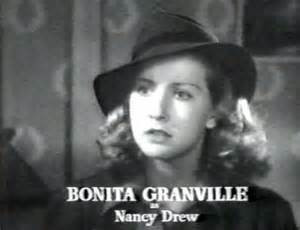
Hitchcock famously refused to drive and Mr Newton’s hesitancy is generally assumed to be based on the director’s. Young Charlie’s ability to drive the family automobile is another link with teen fiction of the era. According to Bobbie Ann Mason, one of Nancy Drew’s chief attractions to her readership was precisely her blue roadster “which carried her into more dangerous situations than usually graced the pages of girls’ books” (Mason, 1995: 16). We never see her behind the wheel because of Uncle Charlie’s murder attempt but it is clear that is she who drives the family to the railway station to collect him. As Michie reminds us, “It is only peripheral details in the film … which is set at a historical moment when women were beginning to have increasing freedom or mobility, a freedom which, in this film, is connected to the ability to drive.” (Michie: 39-40)
Of course, Young Charlie’s unofficial status is matched – doubly so – by the detectives who ingratiate themselves in the guise of national pollsters examining the life of a typical American family, complete with photos. James Graham (Macdonald Carey) and Jack Saunders (Wallace Ford) are clearly uncomfortable in the manner that they have been deputised to assist the countrywide search for the serial killer now dominating the newspapers. But their pose doesn’t fool Young Charlie for long. And, as Everson terms it, they
descend on the town and, virtually convinced of his guilt from prior evidence and masquerading as interviewers for a magazine, work their way into the family’s confidence so they can get a picture of the elusive Uncle Charlie. The restraints, doubts, and dislike for their work under these circumstances are realistically portrayed and they are refreshingly nondramatic in their behaviour.
(Everson, 1973: 205)
Young Charlie’s suspicions and insider knowledge on the killer trump their formal training:
The result is a hybridization of generic conventions: the narrative is driven forward as much by the female protagonist’s personal desires familiar in many types of melodrama (specifically the woman’s film) as by her investigation, which usually drives the narrative of a detective film; however, at the same time, the heroine’s independence as a detective poses an undesirable challenge to the masculinity of her husband (or husband-to-be), as with film noir.
(Gates, 2009: 24-39)
Hitchcock would later deliver his verdict on the dangerously meddlesome police force in The Wrong Man (1957) in which he turns the procedural narrative inside out in a vicious satire of documentary noir using America’s favourite Everyman, Henry Fonda, as the victim of law and order. For Cohen, “the true locus of authority lies not with him [Jack Graham] but with the ordering intelligence of the film itself” (Cohen, 1995: 72).
The powerful antagonist frequently drives the narrative. Story analyst Jeff Flattum states that
We don’t need a serial killer to see the prevalence of phoniness masking evil beneath. Psychopathy, at the extreme, is a good starting point for understanding the spectrum of human behavior in creating a character in storytelling.
We don’t need a serial killer in order to identify a psychopath – but it certainly helps as Flattum ex ains: “… Why psychopaths prove to be so popular in film is clearly obvious in how they represent the two primary elements of storytelling: drama and conflict, or drama born from conflict. They are larger-than-life and capture the imagination. The short definition of what a story is, “ordinary characters in extraordinary circumstances,” is but one way to tell a story” (Flattum, 2013: unpaginated).
Detective and Gothic fiction are clearly linked according to Maria di Battista, writing about Rebecca:
Her heroine descends from Charlotte Bronte’s Jane Eyre and Lucy Snowe, female narrators, whose self-effacing surface manner conceals an imperious, at times ferocious, imagination… She is a compulsive fantasizer, a novelist of her own life who craves for make-believe ‘happiness.’
(di Battista, 2007: 325)
As Fletcher says of Rebecca the novel it “is a 1930s rewriting of Jane Eyre, and it is through a cinematic transposition of du Maurier’s novel that the female Gothic with its Oedipal paradigm decisively enters into combination with the emergent conventions of the Hollywood woman’s film” (Fletcher: 346). While Young Charlie dreams of another more exciting life, Ann reads books obsessively, criticises her father’s hopeless taste in mysteries and relates everything to literature, which she says is “all true,” something Jack Graham warns her about. It is however her advice that Young Charlie takes when she wants information – Ann tells her firmly that she will find what she needs in the town library, as indeed she does and it is this knowledge which decides the story’s outcome. As Elsie Michie points out, reading and writing are the key to solving the mystery (Michie: 45). Mark Jancovich locates the influence of Rebecca on horror and ‘gaslighting’ films of the 1940s. Its success
was largely responsible for initiating a cycle of horror films that were directed at a female audience, and have been excluded from most contemporary treatments of horror… production trends that were intimately related to one another and displayed clear debts to Rebecca, particularly in the situation of their Gothic heroines and the potentially sadistic threat of their male leads. (Jancovich, 2007: 313, 314)
The author continues:
The generic identity of Rebecca is far more directly associated with horror, and established the commercial viability of big-budget, female-centred horror films in the 1940s.
(Jancovich: 315)
And of course the influence is in Hitchcock’s subsequent work, as Rohmer & Chabrol rightly claim:
… Rebecca contains the beginnings of, or the rough sketch for, many elements that were to be refined in later works – for example, the stylization of the acting and the actors based on the relationship between the mobility of one face and the fixed impassiveness of the other, a stylization that was to achieve perfection in Notorious. (R&C: 59)
As Gates reminds us, referencing Catherine Ross Nickerson, detective fiction involving women invariably involves not merely a question of whodunnit but ‘who will marry whom’ and is a blood relative of the Gothic, with early detective fiction retaining the strain of emotional terror that characterises Gothic. For Gates,
The result is a hybridization of generic conventions: the narrative is driven forward as much by the female protagonist’s personal desires familiar in many types of melodrama (specifically the woman’s film) as by her investigation, which usually drives the narrative of a detective film; however, at the same time, the heroine’s independence as a detective poses an undesirable challenge to the masculinity of her husband (or husband-to-be), as with film noir.
(Gates, 2009: 24-39; Nickerson, 1999: 39, 45)
Young Charlie’s pride in being accompanied by her uncle as they walk through the town en route to the bank is caught in the image of her two friends gazing at the couple admiringly at the traffic stop. “It’s wonderful walking with you, Uncle Charlie. I want everyone to see you” (SoD: 66). Young Charlie’s self-knowledge is now dependent on public approval and appearances – from her despair at her mother’s tatty old headgear to her newfound position courtesy of her uncle’s visit, we are observing the tender vine on which her self-esteem rests. She cautions her uncle for teasing her father aloud about embezzling when they reach the bank. When two well-heeled women enter the Manager’s office (one is his wife, the other a wealthy widow) she is keen to introduce Uncle Charlie to make a good impression. Nickerson states that the difference between detective and Gothic fiction resides in their conclusions: the heroine of the detective novel gains a kind of serenity, but both genres “valorize intelligence in women” and “that all serious learning involves self-knowledge” (Nickerson: 14). This is Young Charlie’s personal journey towards self-validation – if she survives, that is.
As Cohen observes, the transition from the nineteenth century narrative from female subjectivity to the cinematic narrative was problematic because “by offering formidable characters for identification, novels can be said to have encouraged a habit of investment that was transferred to film with less satisfying results” (Cohen: 21).
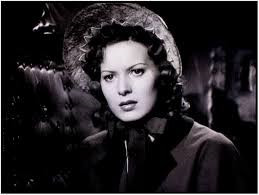
Maureen O’Hara in Jamaica Inn
Hitchcock had read Rebecca while working on Jamaica Inn (1938) and attempted to buy the property but couldn’t afford the asking price. Gothic brushes the shadowy surface of film noir in the 1940 adaptation, surely the most telling narrative and visual template with regard to Hitchcock’s subsequent take on small town American life in Shadow: the nameless girl with a yearning for adventure, plucked from obscurity by a glamorous older man to live in a house haunted by the spirit of his fabulous first wife, who represents the narrator’s ‘Other’. Du Maurier was known to have an interest in psychoanalysis and the narrator is of course a dreamer, sleepwalking between reverie and reality (Wheatley, 2005: 5).
Her heroine descends from Charlotte Bronte’s Jane Eyre and Lucy Snowe, female narrators whose self-effacing surface manner conceals an imperious, at times ferocious imagination… She is a compulsive fantasizer, a novelist of her own life who craves for make-believe ‘happiness’…
(di Battista: 325)
According to Michael Thornton, the origins of Rebecca lay in a series of love letters du Maurier found written to her husband by his former fiancée, a very glamorous society beauty, who threw herself under a train (Thornton, 2005: 42). The theme of Rebecca, which the author acknowledged, was jealousy. David Thomson asserts that
Du Maurier wrote romances, and she liked to have innocent young heroines. But the romance often veers towards something more like horror …
(Thomson, 2007: 308)
Whereof the film adaptation? Alison Light states that
… far from Hitchcock saving her novel, Rebecca provided him with the kind of material that brought out his strengths. Rebecca was in fact a long way from the Edwardian novelette or the standard fare of interwar romance, which is why it survived when so many titles faded into oblivion… A post-romantic novel, it suggested that at the heart of every marriage is a crime.…[It] crosses perfectly that unstable psychological territory of fantasy and obsession, of guilty memory and fearful innocence, which were to become Hitchcock’s hallmark.
(Light, 2007: 297-8)
Thomas Elsaesser locates the beginning of Hollywood’s love affair with Freudian themes in the screen adaptation. He states, “Relating his Victorianism to the Crawford-Stanwyck-Davis type ‘women’s picture’, which for obvious reasons became a major studio concern during the war years and found its apotheosis in such movies as John Cromwell’s Since You Went Away (to the Front, that is), Hitchcock infused his film, and several others, with an oblique intimation of female frigidity producing strange fantasies of persecution, rape and death – masochistic reveries and nightmares, which cast the husband in the role of sadistic murderer” (Elsaesser, 1987: 58). In Shadow Young Charlie begins the film as a daydreamer and thereafter is constantly reminded to wake up: once she has understood her uncle’s litany of crimes she sleeps for a whole day. She is the sleepwalker from German Expressionist cinema who needs to come to terms with reality. The film refuses the ‘happy’ ending that concludes Jane Eyre and is closer in spirit to the displacement and dissatisfaction of foreign exile in Europe that brings our nameless narrator into middle age in Rebecca, subsumed by the ties of marriage to a living death controlled by a dominant husband.
Catholicism was identified as a thematic strand in the director’s output by those critics presumably pre-disposed to the notion; to Truffaut he conceded it played a role, “it does come in, it’s true.” In Shadow this is invoked not merely in the cruciform imagery which characterises the actual shadows of the windows throughout the film but in the identification of Uncle Charlie as the family’s potential saviour. The fact that his arrival in Santa Rosa is heralded with belching black smoke suggests something more diabolical, regularly emphasised by his cigar habit which is clearly a phallic signifier, identified elsewhere. His ‘illness,’ and his draped shoulders suggest a vampire rather than a saint: we are truly in the realm of Bram Stoker with the demonic seduction and possession that such a being implies. James McLaughlin’s essay on the film is focused on this dimension and states that “His most important similarity to Dracula … is that Uncle Charlie is summoned by his niece.” (McLaughlin, 143) David Sterritt refers to the vampire imagery (Sterritt, 1993: 60). Both Francois Regnault and Jean Douchet (Alfred Hitchcock, Paris L’Etoile, 1967: 20-29) refer to the director’s patterning principle: in Shadow we have cruciform patterns dominating windows, behind characters, on stairwells, all carrying the vampiric motif throughout the film. Uncle Charlie preys on his niece and enquires after her whereabouts at regular intervals. This is Gothic at its most fundamental.
The effect of du Maurier can also be seen in what Hitchcock took from the broad strokes of the unhappy (if commercially successful) adaptation of Jamaica Inn (1938), with the innocent niece as protagonist in a strange land, the sadistic uncle (by marriage) and the permanent sense of dread and strange familial situations as well as the threat upon her life. In Rebecca, ‘I’ finds real life wanting in comparison with the contents of the books she is forever reading. Her identity is conferred upon her by feudalistic tradition, her mother having died mere weeks following her father’s demise and now she lives in the home of a glamorous châtelaine whose ghostly being infuses the very air she breathes and whose presence is imbued in every fetish object caressed by Mrs Danvers and, in the film, by the director’s camera.
… although the gothic mode has always permitted the articulation of feminine fear, anger and distrust of the patriarchal order, the films of the war and the post-
war period place an unusual amount of emphasis on the affirmation of feminine perception, interpretation and lived experience.
(Waldman, 1984: 29)
Diane Waldman provides an historical and social context for the growing appeal of the female Gothic narrative: the onset of war; the diminution in family size; the absent husband; all of these factors combined to produce an affective atmosphere in which to exploit female identification and mode of expression. (Waldman: 30).
Waldman describes the fundamental Gothic strategy:
… [T]he central feature of the Gothic is ambiguity, the hesitation between two possible interpretations of events by the protagonist and often … by the spectator as well…. This hesitation is experienced by a character (and presumably a spectator) who is female. Within a patriarchal culture, then, the resolution of the hesitation carries with it the ideological function of validation or invalidation of feminine experience.
(Waldman: 31)
Dresner avers that
… the gothic heroine’s success at investigation comes at the expense of the exposure and censure of a guilty male character, a potentially problematic locus of identification for male spectators. In non-Gothic films, this uncomfortable identification may be mitigated by aspects of a film’s enunciation that code the guilty party as not-male no matter how male he may at first appear to be.
(Dresner: 149)
The author also reminds us that the Gothic (or domestic) narrative doesn’t allow for the female detective to succeed on her own – she requires assistance (39); in Shadow that assistance comes from a policeman who has the power of arrest and who also has a romantic interest in Young Charlie but their first date is supplanted with the initiation of an investigation into her uncle.
When François Truffaut put it to Hitchcock that he owed rather a lot to the influence of du Maurier, the director responded vaguely:
… the whole situation was projected from her [the nameless heroine’s] point of view; she never knew Mrs Danvers might turn up, and this, in itself, was terrifying.
(Truffaut: 129-30)
Theorist Tania Modleski agrees, finding that the female Gothic structure characterises not only Shadow but Suspicion (1941) and Spellbound (1945) (Modleski, 1988: 57). Truffaut attempted to pursue the idea with Hitchcock:
The fablelike quality is of interest because it recurs in several of your works…
Hitchcock responded:
… it’s entirely possible that this abstraction, which you’ve described as American stylization, is partly accidental, and to some extent due to the fact that the picture was made in the United States.
(Truffaut: 131)
As Alison Light relates, “It’s not just that Hitchcock’s Rebecca wasn’t exactly Daphne du Maurier’s; it wasn’t entirely Hitchcock’s either.” It was the “feminine angle… that caused ructions” (Light: 295). “Part of the struggle over the film was between Selznick’s love of the lavish, of expensive costumes and big houses, and Hitchcock’s desire for surface realism and the carefully observed detail of the everyday” (298). The trouble between them is related in detail elsewhere (see Behlmer; and Leff). Thomson summarises Selznick’s dominance in the relationship:
Having arrived in Hollywood, Hitchcock was alarmed by the overbearing manner of Selznick, and was determined to stay independent. So he took the du Maurier novel and turned it into a Hitchcock scenario with a vengeance. In short, he delivered a script that made Selznick howl in complaint. ‘But Hitch, you’re ruined the book!’
… Selznick had learned one thing on Gone With the Wind: if in doubt stay faithful to the book, for millions of readers are prepared to be upset if you make a foolish change. So, bit by bit, and with fierce comic battles, the producer dragged his director back to the du Maurier story.
(Thomson, 2007: 309)
Light pinpoints the difference in the men’s sensibilities:
Slavishness to the literary and, even worse, to the woman’s novel of the 1930s, was compounded by the kind of romantic glamorisation of settings and of actors that offended Hitchcock’s more democratic sensibilities and documentary leanings.
(Light: 296)
There is a case to be made for analysing Hitchcock in terms of the producers and studios who clearly wielded such an influence on his output and as Raymond Durgnat points out, “Quite possibly the influence of Selznick had sensitized him to themes and settings which enabled him to combine suspense with a middle-class ‘women’s angle’” (Durgnat: 19-20). This suggests that an examination of the different phases and trends of Hitchcock’s body of work through the prism of his associations with producers and studios would be fascinating, with Leonard Leff having done the spadework in his study of the director’s career in collaboration with Selznick, cited regularly here (Leff, 2007). Leff states that Selznick “leaned toward the human drama” whereas Hitchcock “privileged form over character, irony and romance” (Leff, 2007: 45). For Leff, “British Hitchcock had been emotionally thin, Rebecca was robust … unlike thirties Hitchcock, the Rebecca screenplay links the cool, stable surfaces of ‘things’ to the perturbed characters’ desires and fears” (Leff: 54). Despite their clear conflict on the subject, Leff states that “during the evolution of the screenplay, Selznick never forced the issue of absolute control, for alienating Hitchcock made no sense” (Ibid.). It is worth looking at some of the minutiae of the exchange between them – primarily of course in those legendary memos attributed to Selznick, in the famed collection edited by Rudy Behlmer, in which some intriguing scenarios arise.
In a memo to Hitchcock dated 12 June 1939 he wrote (or rather, dictated) on the problematic issue of fidelity to Rebecca during the development of the screenplay:
The medium of the radio is certainly no closer to the novel form than is the motion picture. And yet Orson Welles, throwing together a radio script on Rebecca in less than a week’s time, had one of the greatest dramatic successes the radio has ever known by simply assembling ten or fifteen scenes from the book word for word – thereby proving that du Maurier’s Rebecca in any form has the identical appeal that it had in book form. A clever showman, he didn’t waste time and effort creating anything new, but simply gave them the original. I hope we will be equally astute. If we do in motion pictures as faithful a job as Welles did on the radio, we are likely to have the same success the book had and the same success that Welles had. If we create an original script, we can only pray that we’ll get something that is as good and as appealing as what we had and threw away…
[Selznick had acquired the radio rights and sold them to Welles.]
We have removed all the subtleties and substituted big broad strokes which in outline form betray just how ordinary the actual plot is and just how bad a picture it would make without the little feminine things which are so recognizable and which make every woman say, “I know just how she feels … I know just what she’s going through…” etc.
(Behlmer, 1972: 267, 269)
If, as we shall outline, Rebecca (1940) represents an intersection of what would come to be described as film noir with Gothic horror, then most of the paranoid woman’s films of the Forties can be traced to its influence, albeit Wuthering Heights (Wyler, 1939) more or less pre-dated it, as Raymond Durgnat reminds us (Durgnat: 166). Selznick’s script editor Val Lewton (who disliked Hitchcock’s work) would go on to produce a series of acclaimed low budget horrors at RKO, amongst them, I Walked With a Zombie (Tourneur, 1943), owing equal inspiration to Jane Eyre and deploying a woman’s voice over. And, of course, Citizen Kane (1941) ends similarly – with the ‘R’ of Rosebud going down in flames. The tangled skein of influence between Welles and Hitchcock met through Selznick and would crossfertilise in The Stranger (Welles, 1946) with its small town setting and structural echo of pursuit and investigation, with the vampiric hints of Shadow and a clock tower conclusion foreshadowing that of Vertigo; and those fascinating fraternal motel twins Touch of Evil (Welles, 1958) and Psycho (1960), both imperilling that auteur favourite, Janet Leigh. It is not unimportant to our understanding of originary texts to mention that Selznick packaged the production of Jane Eyre (Stevenson, 1943) to star Welles as Rochester and Joan Fontaine as the all-time Gothic heroine; nor that the script was written in the main by John Houseman, Welles’ partner in the Mercury Theatre, which Joseph Cotten joined; nor that Selznick followed Welles’ suggestion that he hire his associate Bernard Herrmann (who had of course scored Citizen Kane) as the soundtrack’s composer. Herrmann would have an influential decade-long relationship with Hitchcock, from The Trouble With Harry (1955) through Marnie (1964).
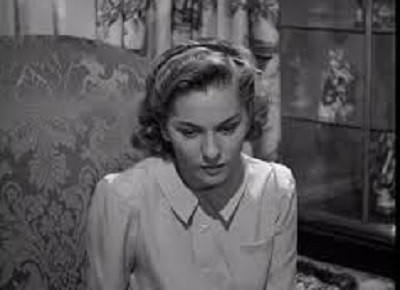
Joan Fontaine in Rebecca
By 18 August 1939 Selznick was able to tell star Laurence Olivier of Rebecca that the “script is coming along splendidly, and glad be able tell you Robert Sherwood is doing final dialogue rewrite” (Behlmer: 280). On the same date he expressed some of his thoughts on casting: “…there are certain stories, such as Rebecca, where miscasting of the girl will mean not simply that the role is badly played but that the whole story doesn’t come off – with, in some cases, the maddening result that the player who has been miscast is credited with a great performance and the picture is considered very bad. I am convinced that we would be better off making this picture with a girl who had no personality whatever and who was a bad actress but was right in type than we would be to cast it with Vivien [Leigh]” (Behlmer, 281). He had originally proposed to the director that Nova Pilbeam (the lead in Young and Innocent) take the role but Hitchcock objected and according to Leff argued that she couldn’t handle the love scenes (Leff: 51). Hitchcock’s contrary views on the actress are expressed in a 1938 article by the director, ‘Nova Grows Up.’ (Gottlieb, 1995: 82-85) Joan Fontaine recalled
I was sitting next to David Selznick at a party and I mentioned that I’d read the book and he said that he’d bought it that day and would I care to test?
(Talking Pictures: Joan Fontaine)
Ultimately Rebecca was altered in adaptation of course, primarily in its conclusions, because of “the inability of the film to deal with female hostility toward men and marriage, the bedrock of du Maurier’s novel, and the flipside too of her delight in Rebecca” (Light: 301). In reality, theoretical implications aside, the conclusion was altered for the practical reasons of censorship. The Hays Office, that is, Joseph Breen and his cohorts, suggested that Rebecca die accidentally in a confrontation with Maxim. As Selznick pointed out in correspondence to John Hay Whitney (the Selznick company’s biggest investor and chairman of its board), dated 6 September 1939: “The whole story of Rebecca is the story of a man who has murdered his wife, and it now becomes the story of a man who buried a wife who was killed accidentally! …” (Behlmer: 285). He wrote to his story editor and trusted lieutenant Kay Brown 27 February 1940 and directed her to please explain to du Maurier the changes to the text: “I was heartbroken because of my desire for complete faithfulness. You might explain that Hays did what the censors would have done anyway – and that is, reject a story in which a murderer goes free” (Behlmer: 297).
Light points out that following the abandoning of the voiceover narration that opens the film, the only stable point of view is that of Jasper, the cocker spaniel. (Light: 302) This presumably neutralises the sexist polarity of dominance and desire.
Rebecca and Shadow have their origins in Greek myth. Both Sigmund Freud and Claude Lévi-Strauss analyse Oedipus Rex, the original detective story, with the latter looking at different versions than Freud, who confines himself to Sophocles’ version. Freud describes it as a ‘a tragedy of sex’; while theorist Paul Ricoeur calls it ‘a tragedy of truth.’ John Belton traces the links between Oedipus and detective fiction and states, “Sophocles construes the epistemological dilemma which characterizes the genre’s interplay between the rational desire to know and the irrational repression of knowledge as an internal one, situating it within his detective hero who is also the criminal he seeks, whereas Poe and other, modern practitioners of the genre externalise it, pitting the rational detective figure against an irrational counterpart” (Belton, 1991: 936). In Shadow, the quest for knowledge is invariably internal since it is familial and personal and even particular to two individuals who share the same name and perhaps the same traits (and bed). Uncle Charlie’s irruption into Charlie’s life could be described in psychological noir terms as the return of the repressed. According to Menard, “It is the progress in late 19th century psychology, literature, and philosophy that forms the basis for Hitchcock’s romantic irony” (Menard, part 2). The irony of the shadow in Shadow of a Doubt is that it lies within Charlie herself, to remain there forever as a secret that weds her to her deranged and charming uncle. When the ‘interviewers’ first arrive, she innocently heads them off at the pass to allow Uncle Charlie enter the house without attracting their attention (73). While Uncle Charlie doesn’t want to be photographed, his sister wants the house to be fixed up and improved with fresh flowers. She certainly doesn’t want to be photographed before she breaks eggs. Young Charlie tells them her uncle’s opinions are not average, and he deserves his privacy. She suggests that they look for another family. A tilted low angle shot reveals Uncle Charlie standing at the shadowy top of the stairwell, listening intently to the encounter below.
Daphne du Maurier was known to be fascinated by psychoanalysis. In terms of the way in which Young Charlie/Uncle Charlie are positioned in a parody of the stages of marriage, from ‘engagement’ to closure at a church service, this could be seen not merely to refute the Gothic trajectory but to reflect du Maurier’s private fascination with incest (Thornton, 2007: 42). It is surmised that Du Maurier herself perhaps wrote
out of an inner tomboy desperate to go on having adventures, desperate not to dwindle into conventional domesticated femininity.
(Roberts, 2007: 9)
However we can see a direct lineage here: from the Gothic narrative, an interest in the splitting of subjectivity and an homage to the Freudian notion of the uncanny. The term female gothic was coined by Ellen Moers in Literary Women (1976). Taylor describes the form:
The Gothic is a kind of hybrid, contradictory text, somewhere between horror and romance, one that exposes and plays on contradictions (especially the safety/danger of domestic space for women) and also purges the home of its associations with the terrifying and the evil – the burning house as symbolic purgation. Because so often focused on a male/female relationship in a domestic setting, it shares many elements with the romantic novel.
(Helen Taylor: 78)
Rebecca Munford refers to
the journey of self-discovery that has become recognised as a mark of the female Gothic tradition.
And of both Rebecca and Angela Carter’s The Bloody Chamber she reminds us that
these Gothic heroines remain haunted by the stirrings of those things they have ‘tried to forget.’
(Munford 2007: 72; 73)
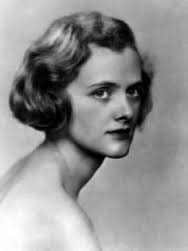
Daphne du Maurier
Light states that
The topography of the Gothic – both in literal and emotional geography – is where Hitchcock really meets du Maurier. Combining the extravagant with psychological realism, it had room for Selznick too… Rebecca recasts many of those elements of the Gothic which had for centuries provided a pre-Freudian vocabulary for what we would call repressed desires.
(Light: 299)
Sally Beauman recommends that one might
examine the subtext of Rebecca and you find a perturbing, darker construct, part Grimm’s fairytale, part Freudian family romance.
(Beauman: 50)
And, Rebecca is a deeply subversive work, one that undermines the very genre to which critics consigned it and denies the erotomania that characterises Wuthering Heights, for example (Beauman: 60). Beauman claims that “Rebecca is narrated by a masochistic woman, who is desperate for the validation provided by a man’s love – a woman seeking an authoritarian father surrogate… (Beauman: 56). She asserts that
The themes of Rebecca – identity, doubling, the intimate linkage between love and murder – recur again and again in du Maurier’s work.
(Beauman: 58)
Beauman also makes a connection between this and the duality that would characterise the author’s life (58):
Throughout her life, she was torn between the need to be a wife and the necessity of being a writer – and she seems to have regarded those roles as irreconcilable …
Given those beliefs, the dualism, the gender-blurring and the splitting that are so apparent in Rebecca become more understandable. Du Maurier was wrestling with her own demons here, and when she gave aspects of herself to the two women who are the pillars of her narrative she was entering into an area of deeply personal psychological struggle.
(Beauman: 59)
One of the governing ideas in examining the paranoid woman’s film is that of the specular (Doane, 1987: 123-154). According to Doane
… in the horror film, what the woman actually sees, after a sustained and fearful process of looking, is a sign or representation of herself displaced to the level of the nonhuman. In the paranoid woman’s film, on the other hand, the female character does not encounter a mutilated signifier of herself but, instead, the traces
of another woman who once occupied her position as wife,…, or even her own iconic image… In both instances of self-confrontation, a narcissistic structure is produced by the collapse of the subject/object distinction.
(Doane: 142)
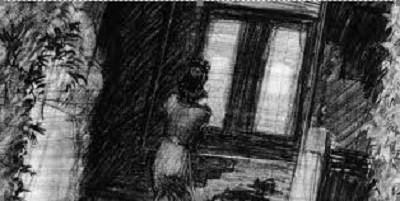
Production sketch – Young Charlie at the library
In Shadow, Young Charlie’s identity is the heart of the matter and the duality of her position is expressed in the camera placement. And, as she tells Jack Graham:
YOUNG CHARLIE
… It’s funny, when I try to think how I feel, I always come back to Uncle Charlie. (she looks at him sharply) Are you trying to tell me not to think he’s so wonderful?
(SoD: 80)
As Yacowar has it, “Hitchcock’s art is based on the dramatic appeal of the secure” (Yacowar: 205). On the outdoor stairs, Uncle Charlie’s shadow is cast and Graham warns Saunders to get a photograph of their supposed target. He destroys the reel in frustration at this breach of his privacy. Jack takes Young Charlie out and once again she impresses her two friends in the company of an older man, although she used a sore throat [linking her with the Merry Widows] as an excuse not to see a movie with them. Then laughter dissolves to tension and romance to thriller when Jack confirms her suspicions for the real reason behind his arrival in Santa Rosa –in the script he hums the Merry Widow Waltz (86): Young Charlie’s entire belief system is challenged. In the background we see the Bank of America looming as though the country itself were under threat.
JACK
There’s a man loose in this country. We’re after him. We don’t know much about him. We don’t even know what he looks like. Charlie, think! How much do you know about your uncle?
(SoD: 87A)
The revelation of the hunt would hurt her mother; Young Charlie must keep quiet and assist the detectives to see if he or the other man back East is the culprit. “If your Uncle Charlie’s the man we want, we’ll get him out of town – quietly – we won’t arrest him here” (88A). Jack pleads with her. The foundations of her life have suddenly collapsed all around her. The script describes her as “completely crushed.” She agrees to the plan. Back at the house Herbie and her father are arguing about effective murder methods once again and wishes them good night and goes up the outside staircase. She opens the door to her own bedroom and takes a piece of crumpled newspaper from the waste-paper basket. This is the second part of the midpoint sequence when the emphasis of the film shifts to express sympathy for Young Charlie and has its conclusion in the library when the initials of one of the Merry Widow murderer’s victims tally with those found on the emerald ring (belonging to Mrs Bruce Matthews, the former musical comedy star known as Teresa Schenley.)
Gates terms the girl reporter’s look “the empowered gaze” (Gates, 2011: 131); while Doane links female paranoia to the “investigating female gaze” (Doane, in Gledhill, 1992: 285.). In what she christens “the paranoid woman’s cycle,” Doane states that “dramas of seeing become invested with horror within the context of the home” (Doane, op.cit.: 286). Dresner stresses the importance of gender and looking:
This ‘creative’ visual power – this ability to guide others’ vision into a particular channel – endows the investigator with a control exactly analogous to the control that the apparatus exerts upon the spectators.
She continues, referencing Laura Mulvey’s essay, ‘Visual Pleasure and Narrative Cinema,’ in terms of entrenched cultural coding in which the female is usually the object of looking:
Does gender affect this paradigm? Yes, very much so: Indeed, the influence of gender on cinematic codes and on individual spectators’ relationship to the apparatus is directly responsible for the insistent cinematic trope of the mad female investigator… the success of this identificatory relay will be helped or hindered by the gender of the investigator on screen: If the investigator is male, this identification between spectator and relaying character should proceed smoothly, especially since investigation – like spectatorship – has been coded as a masculine activity. If the investigator is female, however, this identification might require a more complex negotiation between spectator, character, and camera, since both spectatorships and investigation are emphatically coded as not-feminine activities.
(Dresner, 2006: 116)
However this assertion has been countered and disputed, particularly in Carol J. Clover’s classic study of horror, in which she claims that teenage boys frequently identify with the female protagonists, feeling their fear (Clover, 1992). This is a field explored by Linda Williams in her essay, ‘When the Woman Looks’ (in Doane, Mellencamp, and Williams, 1984: 83-99). As Menard argues, romantic irony is an active structuring principle operating throughout Hitchcock’s work and it is focalised through the individual who ultimately wins the moral argument (Menard, 2008, part 2: unpaginated). How our identification shifts from the elegant, dandified serial killer to his teenaged niece is part of the film’s mastery. How does Hitchcock’s system of ‘looking’ influence our place as spectator in the relationship? “In the case of the classic suspense scenario, in which a person, more often a female, is threatened by an intruder, Hitchcock uses the mechanisms of narrative suspense to trump the spectator’s moral judgment/response, and in so doing the director creates a cyclic ‘back-and-forth’ movement between extreme POVs within the moral arena” (Menard, 2008: unpaginated).
Cohen asserts that Hitchcock’s system of focalisation shifts our sympathies from Uncle Charlie to his niece in a single transitional moment: the overhead shot pulling back from Young Charlie when she reads the newspaper story in the public library about The Merry Widows Murders and slips the emerald ring from her right hand, tucking it into her fist and stands up to make her way to the front door. Cohen describes this shot as paternal: “the paradoxical effect of the overhead shot is to combine the protective gaze with the controlling gaze and to suggest that both spring from the paternal role within the nuclear family” (Cohen, 1995: 73). As in other Hitchcock films, the overhead shot signifies when a deception is revealed. Here we automatically understand the truth of the teenager’s situation, her compromised position and the danger in which she finds herself. Her realisation is emphatically underlined by the camera movement away from her weary figure walking slowly from the desk to the door in the shadow-filled building. Cohen says, “It casts the filmmaker in the role of the unseen, omniscient spectator – the supreme patriarch – looking down on the daughter, humbled by experience and brought back to the fold” (Ibid.). And as Rothman claims it is the moment “our knowledge and Charlie’s for the first time coincide” (Rothman: 210). Uncle Charlie is not just a phantom of Young Charlie’s imagination, he is a phantasmagorical creature followed by journalists, and a monster killing off widows.
For Hanson, “The female gothic heroine is an investigative figure and the generic situations of the gothic story require her to navigate a series of positions conditioned by her speculation about, or knowledge of, events at different moments in that story. The centrality of the protagonist means that unfolding of story events are understood in relation to her, and what the audience understands about her. This ‘relation’ is quite intricate in the female gothic film, where the process of narrating – the structure of arranging through which the reader or spectator learns of the event – is generically motivated by secrecy and concealment, a restriction of knowledge that is a common feature of the mystery narrative” (Hanson, 2007: 53-54).
The film’s third lap dissolve to the waltzers occurs as Young Charlie leaves the library doomed with unwanted knowledge. We are entering the film’s fifty-ninth minute, roughly the half way mark, and an opportune moment to end Part one of this two-part essay.
(See end of Part Two for Full Citations)
Notes
- The town was used as the location of another film that year, Happy Land (Pichel, 1943) which would see the discovery of another little local resident, Natalie Wood, in a bit part. Three years later she would have a substantial role for the same director in Tomorrow is Forever co-starring with Orson Welles. Hitchcock would revisit the vicinity some twenty years later, bringing The Birds to Bodega Bay. The rest is film history. ↩
- The films were all directed by William Clemens from screenplays by Kenneth Gamet: Nancy Drew: Detective (1938); Nancy Drew: Reporter (1939); Nancy Drew: Trouble Shooter (1939); and Nancy Drew and the Hidden Staircase (1939). A new incarnation was filmed in 2007 as Nancy Drew by writer/director Andrew Fleming. The 1970s modern crossover TV series with The Hardy Boys Mysteries (another Stratemeyer creation) is probably the most notable screen interpretation of the character. The books were edited and updated to meet contemporary tastes from 1949; and following the TV series the books navigated new audiences with The Nancy Drew Files (1986-1997), Nancy Drew on Campus (1995-1998), Nancy Drew: Girl Detective (2008-2012), and Nancy Drew Diaries (2013-). These are popular reincarnations of the original, whom Bobbie Ann Mason describes as “the conventional and the revolutionary in one compact image.” (Mason: 138) This is happily confirmed by the bookshelf full of Nancy Drew coveted by an alcoholic movie star in The Morning After (Lumet, 1986) played by Jane Fonda, surely the very epitome of revolutionary and conventional in a single acting and offscreen life. ↩

